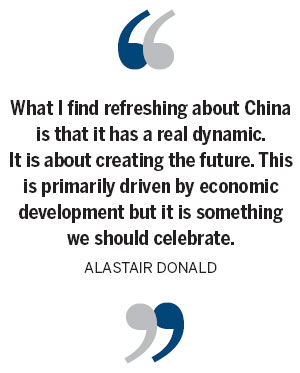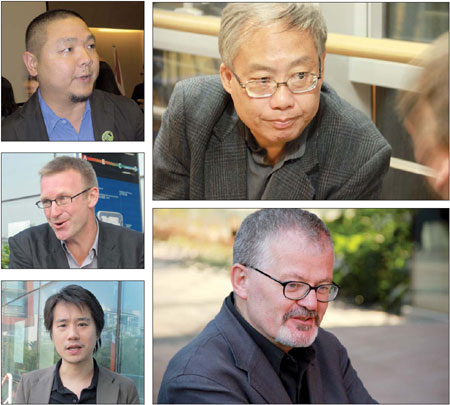City slick
Updated: 2012-11-09 10:01
By Andrew Moody and Yang Yang (China Daily)
|
|||||||||||

As China hurtles toward urbanization, pace of change places immense pressure on municipal planning departments
Those in China designing the cities of the future face an unprecedented challenge - the speed and scale of the country's urbanization is something that no urban planning system has had to deal with in history.
The number of people living in cities in China has increased six-fold from 144 million in 1970 to 691 million this year when, according to the National Bureau of Statistics, more than 50 percent of the population lived in urban areas for the first time. The momentum, if anything, is accelerating with 70 percent forecast to be living in cities by 2035.
In just over a decade from now, China will have 221 cities with more than 1 million people, according to a report by McKinsey & Co, compared with 35 cities of this size in Europe and about 10 in the United States.
This pace of change has placed immense pressure on municipal planning departments across the country.
|
|
Not only have they to provide the housing, infrastructure, mass transit systems and facilities for this rural influx but they are also charged to do so without creating an environmental disaster.
One consequence of this is much of the world's city masterplanning expertise has moved from West to East, whether this be the in-house expertise that now exists within local government or the many Western engineering and architecture practices which have major bases in the country.
Even Sir Peter Hall, regarded as the leading town planner of his generation and who is Bartlett professor of planning and regeneration at University College, London, has said those in the West no longer came to China to teach but to learn from Chinese contemporary planners.
There is estimated to be 18,600 qualified architects and 16,000 urban planners in China and the demand to add to this number from China's top architectural schools such as Tongji University in Shanghai or the School of Architecture at Tsinghua University, has never been greater.
Austin Williams, the convenor of a recent conference - Masterplanning the Future, at Xi'an Jiaotong-Liverpool University in Suzhou - which attracted leading figures in urban planning from around the world, says there is a vision China's planners have that is now lacking in the West. "To do masterplanning you have got to have a visionary mindset and that just isn't the West anymore. Chinese ambition is almost palpable when you walk the streets of Shanghai. Tomorrow is their future. Not some architect from Cleethorpes," he says.
Alastair Donald, associate director of the Future Cities Project, an independent body which is a forum of debate on urban development, agrees China's urban progress creates a mood of looking forward, rather than back, as he believes is now often the case in the West.
|
Clockwise from top left: Li Xiangning, associate professor of architectural history, criticism and theory at Tongji University in Shanghai; Pu Miao, professor of architecture at the University of Hawaii; Austin Williams, who lectures on architecture at Xi'an Jiaotong-Liverpool University in Suzhou; Daniel Koo, project architect with David Chipperfield Architects in Shanghai; Alastair Donald, associate director of the Future Cities Project. Photos by Yang Yang / China Daily |
"What I find refreshing about China is that it has a real dynamic. It is about creating the future. This is primarily driven by economic development but it is something we should celebrate -- that developing countries like China are emerging from the poverty of the past and into a much more materially better future."
Whether there are now divergent ideas in terms of how to build and design a city compared to the West is much debated.
Li Xiangning, associate professor of architectural history, criticism and theory at the Tongji University's College of Architecture and Urban Planning in Shanghai, says China's planners are more interested in the aesthetics of the urban environment than those in the West.
"Chinese urban planning is more about the physical appearance of a city, the built environment, the spaces and the arrangement of the buildings," he says.
"The Western model is more based on analysis of the population, economic and social statistics, where people live in terms of where they might find jobs. One of the reasons for this is that a lot of Chinese planners study architecture first whereas in the West they come from an urban planning educational background."
|
||||
"Affordable housing in Chinese cities is often put in the extreme outskirts of cities, where it is often difficult to access the mass transport systems," he says.
"It makes it a struggle for workers to get into the city centers where most of them find employment. In European cities, the more affordable housing tends to be found on the edge of the center, the so-called inner city areas."
Twinn, who has been in the country for eight years and was a consultant for China's first eco city scheme at Dongtan on an island near Shanghai, planned to have a population of Manhattan by 2050 but has yet to be started, says China's urban planners have made great strides but still need to up their game.
"I would certainly say there is more masterplanning being done here and it is drawing in people from across the world. I wouldn't necessarily say it was anywhere as advanced as in certain other countries," he says.
"The planning system in China is maturing but it is on that certain point of the curve where there is plenty of scope for maturing."
Today's Top News
Rescuers race against time for quake victims
Telecom workers restore links
Coal mine blast kills 18 in Jilin
Intl scholarship puts China on the map
More bird flu patients discharged
Gold loses sheen, but still a safe bet
US 'turns blind eye to human rights'
Telecom workers restore links
Hot Topics
Lunar probe , China growth forecasts, Emission rules get tougher, China seen through 'colored lens', International board,
Editor's Picks

|

|

|

|

|

|











